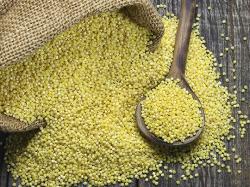Could Millet Be The Next Whole Grain Superstar?
July 29, 2015 | 2 min to read

Millet, known mostly as a birdseed ingredient, is one of the “ancient grains” appearing in items on restaurant menus and in baked goods. Although there’s no historical or botanical definition of what exactly constitutes an ancient grain, the category typically includes amaranth, barley, bulgur, buckwheat, kamut, millet, spelt, teff and quinoa, which are viewed as alternatives to modern wheat. “It’s been a positive perfect storm for these ancient grains,” says Cynthia Harriman, Director of Food and Nutritional Strategies at the Whole Grain Council. “They fit with our desire to look for a super-food, a magic bullet we should be eating.”
Following the quinoa craze, millet could be next in line for stardom. But even though it was named in Time® magazine’s, “Here Are the Only 6 Food Trends You Need to Know for 2015,” it’s still relatively unknown. “It’s at the beginning of the very first stage of trend adoption,” says Maeve Webster, Senior Director for Market Research at Datassential. Webster states, “We’re seeing it as one ingredient in multi-grain bread, veggie burgers and flapjacks…but clearly these items are targeted to hard-core healthy eaters, not the mainstream.”
In addition to its health halo, millet may have an agricultural benefit. “Millet can be grown with much less water than wheat,” says Arlin Wasserman, Chair of the Menus of Change Sustainable Business Leadership Council at The Culinary Institute of America and the Harvard School of Public Health and a principal and the founder of Changing Tastes, a strategy and innovation consultancy. “When we think about ways to use less water and avoid volatile food costs, millet is a good solution,” suggests Wasserman.
To read the rest of the story, please go to: Cargill InPerspective
